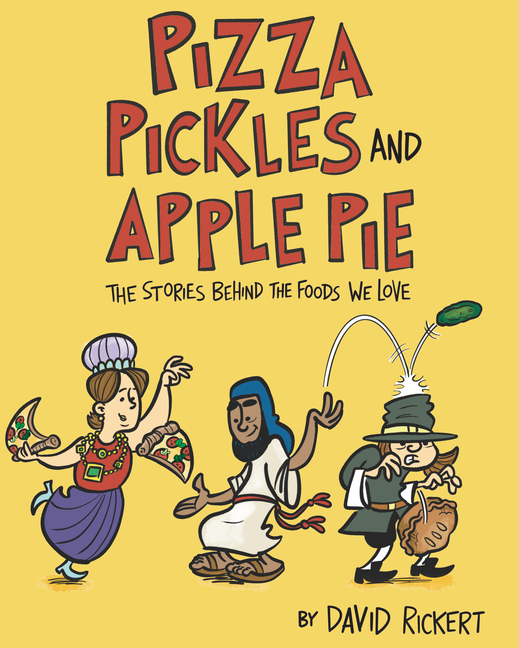From Teaching to Writing

TeachingBooks asks each author or illustrator to reflect on their journey from teaching to writing. Enjoy the following from David Rickert.
Learning the Hard Way
by David Rickert
Maybe it’s the teacher in me, but there’s nothing I like better than taking a deep dive into new subjects. So when the idea for writing a book about the history of food presented itself, I knew I was going to have a terrific time doing the research. (And besides, who doesn’t love food?) I checked out a bunch of books from the library, sought out a few promising websites, and got to work.
But I quickly found out that while research is fun, it’s also really hard! And writing Pizza, Pickles, and Apple Pie (Astra Books, 2023) reminded me of that.
So here are some valuable lessons about research I learned from working on Pizza, Pickles, and Apple Pie.
The Truth Can Be Difficult to Track Down

Some facts, like why popcorn pops, can be easy to find. Others, such as who invented fried chicken, don’t provide an easy answer. In many cases, the origin of a food was difficult to determine, and scientists and anthropologists are simply making the best guess they can from scant evidence of shattered earthenware and remnants of ancient food. There’s no definite answer.
Other problems exist with stories that are treated as fact, but are actually fiction. Many people believe that Queen Margherita popularized the margherita pizza, but that story has been regarded by many as legend (the story is still in Pizza, Pickles, and Apple Pie, but presented as such). The “facts” tell us that John Montagu invented the sandwich so he could eat with one hand and still play cards. But there’s better evidence that he was actually a workaholic who wanted to be able to eat and read and write at the same time. I found more sources that told the card playing story, but the most reliable source had the work anecdote. So that’s the one I included.

In many cases, doing thorough research complicated matters for me. It required a diligent search for the truth amidst many prevailing theories, and a desire to find the most likely answer when the truth wasn’t easy to find. It’s not easy, but it is important.
Double Check Everything
My biggest fear when working on Pizza, Pickles, and Apple Pie was that some food aficionado would read it and say “Actually, here’s what really happened …” We all know that it’s important to back up sources and not rely heavily on one source. Therefore, I double checked my information. The more sources I could find that had the same facts, the better. If I couldn’t find a fact in multiple sources, I had to think about whether to include it.

I also had to consider the sources I was using. Many sushi restaurants have a “history of sushi” page on their website. But who did the research? Where did they get their information? (None of them had citations). There was also a fun story I found about a sub shop that sued a burrito company claiming that burritos were sandwiches and therefore violated the “one sandwich shop” rule in a mall. But I wasn’t able to find it documented anywhere except for Wikipedia. So, despite being a great story (and who hasn’t participated in the “is a hot dog a sandwich” debate?) It had to go.
Do an Outline
Like many teachers, I have had my share of students that want to turn in an outline after they have finished their essays. But we all know that planning is the most important part of the process, and where a paper can sideways before it gets written.
I learned too late that a good outline was essential. In the beginning I was so excited to start writing that I didn’t plan it out first. But I found that unless I was working from an outline, I had no sense of whether my pickles chapter was going to be 8 pages or 18, or whether I had too much text on any given page in the pizza chapter. I had to cut out chapters, like “Pretzels,” that I didn’t have space for. As a result, I had to edit out a lot of hard work that I could have avoided if I had started with an outline.

I am currently working on my second book, and this time I did the outline first. I knew how many pages I had to work with in each section, making sure that each new chapter started on an odd page for continuity. Once I started writing the script and the layouts, I had a good idea of how many pages I had to work with and how much text would comfortably fit on one page. I also took a chapter out and absorbed it into other sections. The outline saved me time I wasted with Pizza, Pickles, and Apple Pie creating sections that never made it into the final draft.
In Conclusion
I took these lessons back to my classroom for my students to learn from. While their persuasive essays are low risks (not many people will actually read them) what I taught them had practical value with a published book. I was able to share with my students that this is why finding multiple credible sources and backing them up matter. Research is never easy, as I was reminded of while finding facts about the foods we eat, but doing it properly is a lesson our students need to learn. Who knows? They might write a non-fiction book of their own someday!
Books and Resources

TeachingBooks personalizes connections to books and authors. Enjoy the following on David Rickert and the books he’s created.
Listen to David Rickert talking with TeachingBooks about the backstory for writing Pizza, Pickles, and Apple Pie. You can click the player below or experience the recording on TeachingBooks, where you can read along as you listen, and also translate the text to another language.
- Listen to David Rickert pronounce his name
- Enjoy this book trailer for Pizza, Pickles, and Apple Pie
- Discover David Rickert’s page and books on TeachingBooks
- Visit David Rickert on his website, Twitter, Instagram, YouTube, LinkedIn, and his GoodReads page.
Explore all of the For Teachers, By Teachers blog posts.
Special thanks to David Rickert and Astra Books for their support of this post. All text and images are courtesy of David Rickert and Astra Books and may not be used without expressed written consent.



Leave a Reply